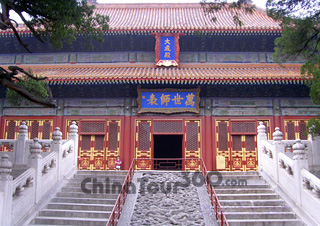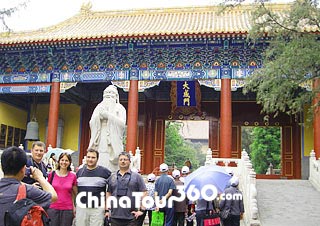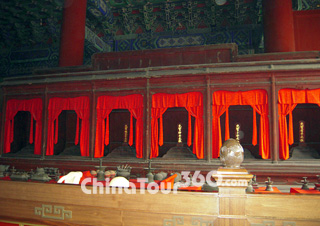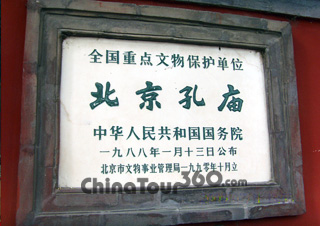 Decheng Hall
Decheng Hall Confuciou's Temple, Beijing
Confuciou's Temple, Beijing Twelve Philosophers
Twelve Philosophers Beijing Confucius Temple
Beijing Confucius Temple
The Temple of Confucius, the present site of the Capital Museum, is located at the eastern end of Guo Zijian (Imperial College), Chengxian Street, East District of Beijing with an area of 22,000 square meters (5.4 acres). It is built in memory of the great philosopher, thinker, educationalist Confucius in ancient times.
The temple in Beijing was initially built in 1302 and renovated during the Ming (1368 - 1644) and Qing (1644 - 1911) Dynasties. It is the second largest temple constructed for Confucius, ranking only behind the one in Qufu, Shandong Province. Comparatively speaking, the Confucius Temple in Qufu is much larger in size, but this one in Beijing is much more socially important than that in Qufu, because the imperial officials of the Yuan (1271 - 1368), Ming and Qing Dynasties all came to Beijing Confucius Temple to pay respect to the ancient sage Confucius, they used to host the memorable ceremonies to honor Confucius in the 2nd and 8th months of the Chinese calendar, thus it is matchless in the Chinese feudal society.
There are four courtyards in the temple. The main structures include Xianshi Gate (Gate of the First Teacher), Dacheng Hall (Hall of Great Accomplishment), Dacheng Gate (Gate of Great Accomplishment) and Chongshengci (Worship Hall). Dacheng Hall is the main building in the temple, where the memorial ceremonies for Confucius were often held. It is about 16.4 meters (17.9 yards) in width and 5 meters (5.5 yards) in length. Going inside the temple the 198 stone tablets placed on either side of the front courtyard can be seen, which bear more than 51,624 names of Jinshi (the advanced scholars) of the Yuan, Ming and Qing dynasties who passed the imperial examination, and 14 stone stele pavilions of the Ming and Qing dynasties that keep the record of the precious historical information of ancient China.
The Confucius Temple houses many precious historical and cultural relics including the Qian Long stone drums, the inscribed boards, stone tablets inscribed with the full messages of the thirteen Confucian masterpieces, and stone tablets bearing the names and origins of scholars who passed the highest examination.
There are also some noteworthy pictures in the temple. One outlines two flying dragons playing a pearl among clouds, which can only be used in the imperial palaces in ancient China as dragon stands for emperor in the past. Therefore, it is not difficult to imagine the importance of the Confucius Temple in the feudal society of China.
To better commemorate Confucius and his accomplished principles, the Confucius temple was designated as one of the major national historical and cultural sites under the national protection of the State Council in 1988.
![]() Entrance Fee: CNY 30 (through ticket including the Confucius Temple and the Imperial College)
Entrance Fee: CNY 30 (through ticket including the Confucius Temple and the Imperial College)
![]() Transportation:
Transportation:
A. Bus Routes:
Take Bus No. 13, 116 or 807 and get off at Yonghegong (the Lama Temple) Stop;
Take Bus No. 104, 108, 113, 407 and get off at Andingmen Stop.
B. Subway:
Take Subway Line 2 or 5 and get off at Yonghegong Station
![]() Opening Hours 09:00 - 17:00
Opening Hours 09:00 - 17:00








